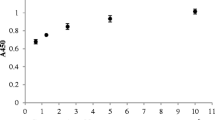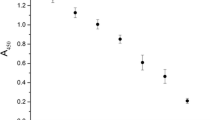Abstract
A fluorescent single-domain antibody (fluobody), a fusion protein of a green fluorescent protein extracted from Aequorea coerulescens (AcGFP), a mutant that has been codon-optimized for mammalian expression, and a single-chain variable fragment antibody (scFv), against plumbagin (5-hydroxy-2-methyl-1,4-naphthoquinone; PL) was successfully constructed and expressed in Escherichia coli. The expressed fluobody was purified, refolded, and characterized to develop a speedy, simple, and sensitive fluorescence-linked immunosorbent assay (FLISA) for the determination of PL. In this study, two kinds of fluobody containing PL-scFv at the N-terminus of AcGFP (N fluobody) or the C-terminus of AcGFP (C fluobody) were constructed with flexible amino acid linker (Gly4Ser)2 between PL-scFv and AcGFP for comparative purposes. Characterization of the fluobodies revealed that the C fluobody has better properties as a probe for FLISA than the N fluobody because the fluorescence intensity of C fluobody was 18-fold higher than that of N fluobody. Moreover, C fluobody exhibited a fourfold-higher binding affinity than the N fluobody. More interestingly, the limit of detection for PL measurement in FLISA (24 ng mL−1) was improved to eightfold higher than that in conventional ELISA (0.2 μg mL−1), indicating that a sensitive immunoassay could be developed by using fluobody instead of monoclonal antibody or scFv.







Similar content being viewed by others
References
Lin LC, Yang LL, Chou CJ (2003) Phytochemistry 62:619–622
Curreli N, Sollai F, Massa L, Comandini O, Rufo A, Sanjust E, Rinaldi A, Rinaldi AC (2001) J Basic Microb 41:253–259
Likhitwitayawuid K, Kaewamatawong R, Ruangrungsi N, Krungkrai J (1998) Planta Med 64:237–241
Medentsev AG, Akimenko VK (1998) Phytochemistry 47:935–959
Wang YC, Huang TL (2005) J Chromatogr A 1094:99–104
Itoigawa M, Takeya K, Furukawa H (1991) Planta Med 57:317–319
de Paiva SR, Figueiredo MR, Aragão TV, Kaplan MAC (2003) Mem Inst Oswaldo Cruz 98:959–961
Bhargava SK (1984) Indian J Exp Biol 22:153–156
Ding Y, Chen ZJ, Liu S, Che D, Vetter M, Chang CH (2005) J Pharm Pharmacol 57:111–116
Srinivasan L, Mathew N, Muthuswamy K (2009) Parasitol Res 105:1179–1182
Hsu YL, Cho CY, Kuo PL, Huang YT, Lin CC (2006) J Pharmacol Exp Ther 318:484–494
Sandur SK, Ichikawa H, Sethi G, Ahn KS, Aggarwal BB (2006) J Biol Chem 281:17023–17033
Babula P, Mikelova R, Adam V, Kizek R, Havel L, Sladky Z (2006) J Chromatogr B 842:28–35
Hsieh YJ, Lin LC, Tsai TH (2005) J Chromatogr A 1083:141–145
Hermanson GT (1996) Bioconjugate techniques. Academic, San Diego, pp 297–364
Souriau C, Hudson PJ (2001) Expert Opin Biol Ther 1:845–855
Casey JL, Coley AM, Tilley LM, Foley M (2000) Protein Eng 13:445–452
Peipp M, Saul D, Barbin K, Bruenke J, Zunino SJ, Niederweis M, Fey GH (2004) J Immunol Methods 285:265–280
Cao M, Cao P, Yan HJ, Ren F, Lu WG, Hu YL, Zhang SQ (2008) Appl Microbiol Biotechnol 79:423–431
Olichon A, Surrey T (2007) J Biol Chem 282:36314–36320
Kim IS, Shim JH, Suh YT, Yau KYF, Hall JC, Trevors JT, Lee H (2002) Biosci Biotechnol Biochem 66:1148–1151
Oelschlaeger P, Srikant-Iyer S, Lange S, Schmitt J, Schmid RD (2002) Anal Biochem 309:27–34
Sakamoto S, Putalun W, Tsuchihashi R, Morimoto S, Kinjo J, Tanaka H (2008) Anal Chim Acta 607:100–105
Sakamoto S, Taura F, Putalun W, Ponkitwitoon B, Tsuchihashi R, Morimoto S, Kinjo J, Shoyama Y, Tanaka H (2009) Biol Pharm Bull 32:434–439
Bradford MM (1976) Anal Biochem 72:248–254
Umetsu M, Tsumoto K, Hara M, Ashish K, Goda S, Adschiri T, Kumagai I (2003) J Biol Chem 278:8979–8987
Laemmli UK (1970) Nature 227:680–685
Towbin H, Staehelin T, Gordon J (1979) Proc Natl Acad Sci USA 76:4350–4354
Friguet B, Chaffotte AF, Djavadi-Ohaniance L, Goldberg ME (1985) J Immunol Methods 77:305–319
Weiler E, Zenk MH (1976) Phytochemistry 15:1537–1545
Acknowledgments
This work was funded by the Research Fellowship of the Japan Society for the Promotion of Science for Young Scientists. The research in this paper was also supported, in part, by a Grant in Aid from the Japan Society for the Promotion of Science Asian CORE Program; the Ministry of Education, Culture, Sports, Science, and Technology of Japan; and the National Center for Genetic and Biotechnology (BIOTEC), Thailand
Author information
Authors and Affiliations
Corresponding author
Rights and permissions
About this article
Cite this article
Sakamoto, S., Taura, F., Pongkitwitoon, B. et al. Development of sensitivity-improved fluorescence-linked immunosorbent assay using a fluorescent single-domain antibody against the bioactive naphthoquinone, plumbagin. Anal Bioanal Chem 396, 2955–2963 (2010). https://doi.org/10.1007/s00216-010-3535-9
Received:
Revised:
Accepted:
Published:
Issue Date:
DOI: https://doi.org/10.1007/s00216-010-3535-9




